July 2016 LIP of the Month
Importance of geochemistry as a fingerprinting tool for LIPs: Example from Proterozoic mafic magmatism in the Belt-Purcell Basin and Wyoming province of western Laurentia
Chris Rogers
PhD Candidate Ottawa-Carleton Geoscience Centre, Department. of Earth Sciences, Carleton University, 1125 Colonel By Drive, Ottawa, Canada K1S 5B6
Email: Chris.Rogers@Carleton.ca
Richard Ernst
Ottawa-Carleton Geoscience Centre, Department. of Earth Sciences, Carleton University, 1125 Colonel By Drive, Ottawa, Canada K1S 5B6;
Faculty of Geology and Geography, Tomsk State University, 36 Lenin Ave, Tomsk, 634050, Russia
Email: Richard.Ernst@ErnstGeosciences.com
Brian Cousens
Ottawa Carleton Geoscience Centre, Department. of Earth Sciences, Carleton University, 1125 Colonel By Drive, Ottawa, Canada K1S 5B6
Email: Brian.Cousens@Carleton.ca
Ulf Söderlund
Department of Earth & Ecosystem Science, Lund University, Sweden.
Email: Ulf.Soderlund@geol.lu.se
Steve S. Harlan
9209 Fairway Court, Manassas Park, VA 20111, USA.
Email: sharlan92@gmail.com
Alana Mackinder
Ottawa Carleton Geoscience Centre, Department. of Earth Sciences, Carleton University, 1125 Colonel By Drive, Ottawa, Canada K1S 5B6
Email: AlanaMackinder@cmail.carleton.ca
Based on:
Rogers, C., Mackinder, A., Ernst, R., Cousens, B. (2016a). Mafic Magmatism in the Belt-Purcell Basin and Wyoming Province of Western Laurentia. Geological Society of America Special Papers 522 (in press).
and
Rogers, C., Ernst, R. E., Cousens, B., Soderlund, U., Hamilton, M., Harlan, S. S. (2016b). Newly Recognized 1550-1590 Ma Tobacco Root -Western Channel Lip, and Further Evidence for Bringing South Australia Back Home to Western Laurentia. GAC-MAC. Whitehorse, YT: GAC-MAC.
Introduction
Large Igneous Provinces (LIPs) are large volume, mainly short duration, intraplate events of dominantly mafic composition (Ernst 2014). The constituent magmatic units of LIPs (primarily dykes, sills, layered intrusions, and volcanic rocks) are recognized mainly on the basis of matching ages (ideally based on precise U-Pb dating of zircon or baddeleyite), matching primary paleomagnetic directions, and/or a simple geometric relationship of dykes (e.g. a radiating dyke swarm) (e.g. Bleeker and Ernst 2006). One important tool that has been underutilized until recent years is geochemistry. Trace element and isotope geochemistry can be used to recognize intermixed intraplate magmatic units with distinct compositions that can either represent separate events or distinct geochemical packages within a LIP (e.g. Ernst, 2014 and references therein).
Proterozoic intraplate mafic magmatism in western Laurentia represents a useful example in which geochemical discriminants can demonstrably resolve intermixed events (Rogers et al. 2016a). This magmatism was originally thought to be related to either the ca. 780 Ma Gunbarrel LIP (Feb. 2004, LOTM http://www.largeigneousprovinces.org/04feb) or the ca. 1460 Ma Moyie-Purcell LIP (Figure 1; published dates located in Figure 2 and summarized in Table 1a and 1b). A comprehensive regional geochemical analysis involving 204 samples of dolerite dykes and sills (Rogers et al. 2016a), augmented with 103 analyses from Anderson and Goodfellow (2000) shows that there are in fact numerous distinct geochemical groups (at least 17) that argue for the presence of more than just these two previously recognized LIPs (Figure 3a-c). The geochemical evidence led to a test by U-Pb dating which confirmed the presence of entirely new, previously unrecognized magmatic provinces of different age.
Table 1a: Summary of published geochronological ages for the ca. 1460 Ma Moyie-Purcell LIP, including the new U-Pb ages discussed herein. Modified from Rogers et al. (2016a)
|
Moyie-Purcell LIP |
|||||
|
Dyke or Sill |
Age |
Dating Method |
Author |
Year |
Number |
|
Moyie Sills (GS 2-5) |
1468±2 Ma |
U-PbZr |
Anderson and Davis |
1995 |
1 |
|
Goat Flat Dyke (GS 6) |
1471±3 Ma |
U-PbZr In-Situ |
Chamberlain et al. Chamberlain pers. com. |
2000; 2014 |
OMA |
|
Diorite Dyke |
1378.7±1.2 Ma |
U-PbZr |
Doughty and Chamberlain |
1996 |
2 |
|
Amphibolite Dyke |
1463±6 Ma |
U-PbZr |
Doughty and Chamberlain |
2008 |
3 |
|
Purcell Lava |
1447±7 Ma |
U-PbZr |
Evans et al. |
2000 |
4 |
|
Dyke (GS 7) |
1448±49 Ma |
Sm-NdWR |
Harlan et al. |
2005 |
5 |
|
Plains Sill (GS 11) |
1469±2.5 Ma |
U-PbZr |
Sears et al. |
1998 |
6 |
|
Paradise Sill (GS 12) |
1457±2 Ma |
U-PbZr |
Sears et al. |
1998 |
7 |
|
Crossport Sill |
1433±10 Ma |
U-PbZr |
Zartman et al. |
1982 |
8 |
|
Dykes, TRM (Group A;GS 7) |
1455±125 Ma |
Rb-SrWR |
Wooden et al. |
1978 |
9 |
|
Dykes, TRM (Group C; GS 8) |
1130±130 Ma |
Rb-SrWR |
Wooden et al. |
1978 |
10 |
|
Dykes, TRM (GS 7; Ramshorn Creek group) |
1552 ± 6 Ma |
U-PbBa |
Rogers et al. |
2016a |
9 |
|
Dykes, TRM (GS 8; Mammoth group) |
1590 ± 3 Ma |
U-PbBa |
Rogers et al. |
2016a |
10 |
|
Note: TRM—Tobacco Root Mountains; Zr—zircon; WR—whole rock; Ba–baddeleyite; Hbl—hornblende; OMA—outside map area. NC—no precise coordinates available. Group A and C dykes have been reorganized to correspond to GS 7 and GS 8, the Ramshorn Creek and Mammoth groups respectively. See Rogers et al. (2016b) for details of reorganization of Groups A and C from Wooden (1975). Ages for the Ramshorn Creek and Mammoth Groups of the Tobacco Root Mountain event have been added to the table from Rogers et al. (2016b) |
|||||
Table 1b: Summary of published geochronological ages for the ca. 780 Ma Gunbarrel LIP. Modified from Rogers et al. (2016a)
|
Gunbarrel LIP |
|||||
|
Dyke or Sill |
Age |
Dating Method |
Author |
Year |
Number |
|
Sill Tsezotene |
779.5±2.5 Ma |
U-PbBa |
Harlan et al. |
2003 |
OMA |
|
Sill, Concajou |
779.5±2.5 Ma |
U-PbBa |
Harlan et al. |
2003 |
OMA |
|
Sills, Hottah Sheets |
780±1 Ma |
U-PbBa |
Harlan et al. |
2003 |
OMA |
|
Dyke, Muncho (GS 1) |
777.3±3 Ma |
U-PbBa |
Harlan et al. |
2003 |
NC |
|
Sill, Holland Lake (GS 1) |
777.5±2.5 Ma |
U-PbZr |
Burtis et al. |
2007 |
11 |
|
Sill, Wolf Creek (GS 1) |
776±5Ma |
U-PbBa |
Harlan et al. |
1997 |
12 |
|
Dykes, TRM (Group B; GS 1) |
1120±185 Ma |
Rb-SrWR |
Wooden et al. |
1978 |
13 |
|
Dykes, TRM (Group B; GS 1) |
769±7 Ma |
U-PbZr |
Harlan |
1993 |
14 |
|
Dykes, TRM (Group B; GS 1) |
782.4±4.9 Ma |
40Ar-39ArHbl |
Harlan et al. |
2003 |
15 |
|
Dyke, Christmas Lake (GS 1) |
750 Ma |
Rb-SrWR |
Mueller and Rogers |
1973 |
NC |
|
Dyke, Christmas Lake (GS 1) |
774±4 Ma |
40Ar-39Ar |
Harlan et al |
1997 |
NC |
|
Dyke, Christmas Lake (GS 1) |
779.5±3 Ma |
U-PbBa |
Harlan et al |
2003 |
16 |
|
Dyke, Mount Moran (GS 1) |
775 Ma |
Rb-SrWR, K-Ar |
Reed and Zartman |
1973 |
OMA |
|
Dyke, Mount Moran (GS 1) |
765±5 Ma |
40Ar-39Ar |
Harlan et al. |
1997 |
OMA |
|
Note: TRM—Tobacco Root Mountains; Zr—zircon; WR—whole rock; Ba–baddeleyite; Hbl—hornblende; OMA—outside map area. NC—no precise coordinates available. Modified from Rogers et al. (2016b). |
|||||

Figure 1: Location map of Proterozoic dykes and sills in western Laurentia with intraplate setting. The black circles are locations of known Gunbarrel dykes and/or sills, the remaining grey dykes and sills were presumed to be part of the Moyie-Purcell LIP. Modified from Rogers et al. (2016a).
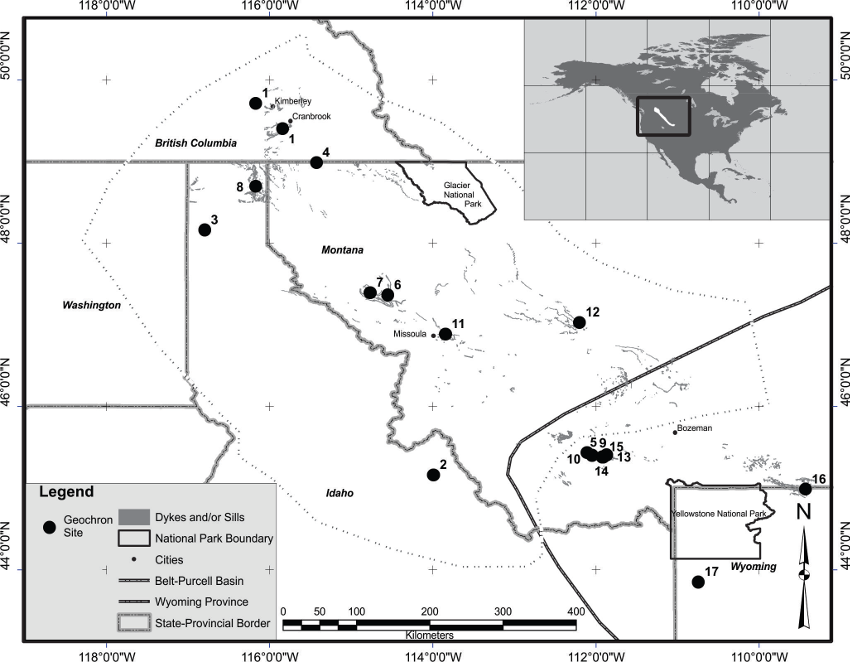
Figure 2: Distribution of samples associated with the individual geochemical groups (GS, Geochemical Signatures). Symbols identify sample sites belonging to the different geochemical groups (see legend) and fields identify individual geochemical groups when individual symbols would be too crowded. Modified from Rogers et al. (2016a).
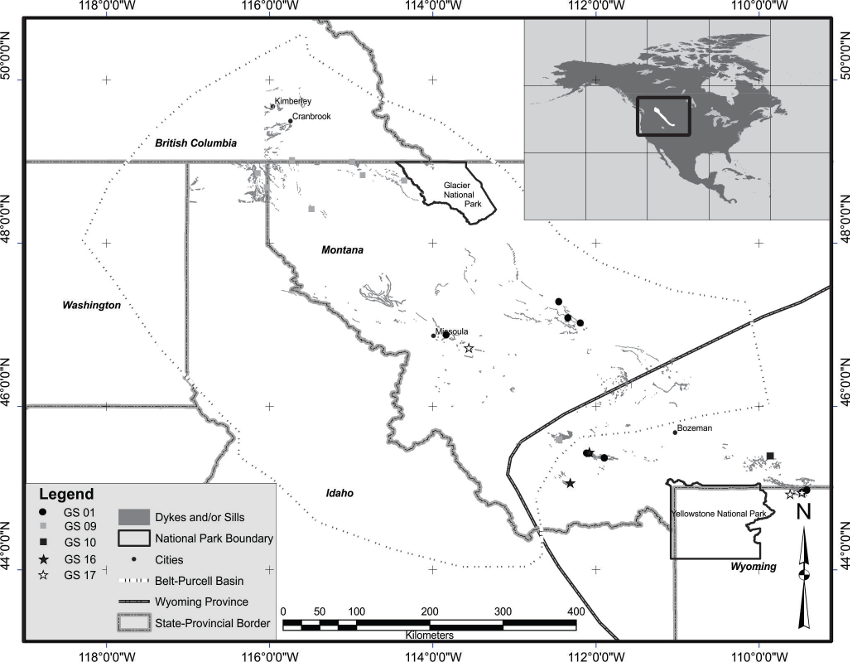
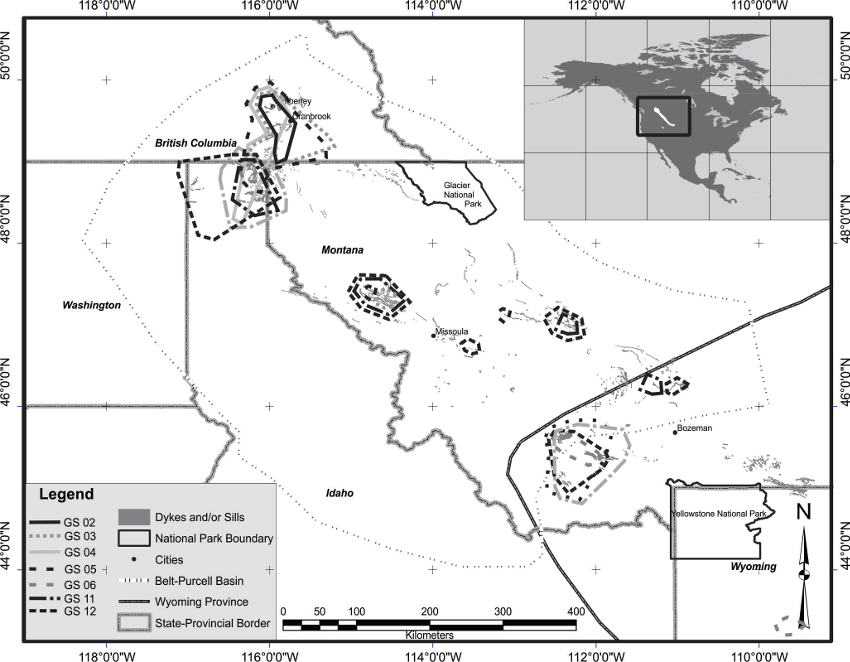
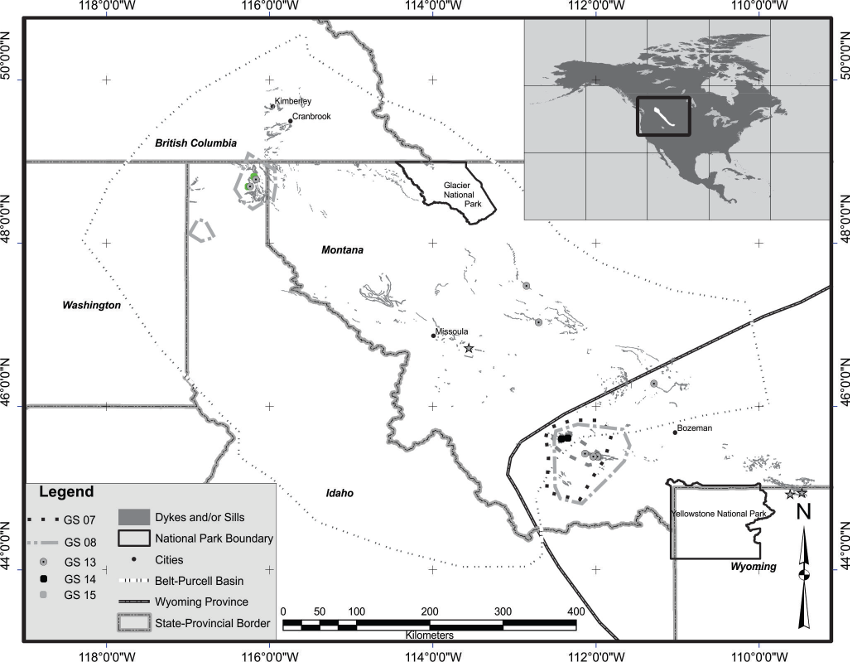
Figure 3a-c: Location map of geochronology sample sites that were presumed to belong to either the ca. 780 Ma Gunbarrel LIP or the ca. 1460 Ma Moyie-Purcell LIP. There are two locations for site 1; these are different collection sites that resulted in the same age (Anderson and Davis 1995). Corresponding data are presented in Table 1. Figure 3 and Table 1a and 1b are modified from Rogers et al. (2016a).
Geochemical Signatures of Western Laurentia
Key trace element parameters used to distinguish separate compositional groups in this study include the following: rare earth (Figure 4) and multi-element (Figure 5) plot patterns, Ti-V plots (Figure 6), and Th/Yb-Nb/Yb plots (Figure 7) (summarized in Table 2); these collectively highlight differences in depth of melting, degree of melting, and interaction between these melts and the continental lithosphere. Full details of this approach are explored in Rogers et al. (2016a). The mafic magmatism, originally grouped into either the ca. 780 Ma Gunbarrel LIP or ca. 1460 Moyie-Purcell LIP, can now be divided into at least 17 geochemical groups. Some of these geochemical groups are expected to represent new intraplate events, potentially of LIP scale. The specifics of new geochemical groupings are shown below, and more fully detailed in Rogers et al. (2016a).
Table 2:Summary of REE and Ti/V slopes for each geochemical signature in Western Laurentia. Abbreviations are defined as follows: n = number of samples used for calculations, R = Range of values, A=Average values, R2 = Goodness of fit of the slope, YI = Y-intercept (Vanadium), Sl = Slope. Regression lines were calculated using the tightest clustering of samples, outliers were removed from the calculations. The degree of partial melt is estimated based on approach in Rollinson (1993) and White (2013).
|
Group |
REE Slope (La/Yb)PM |
Light REE Slope (La/Sm)PM |
Heavy REE Slope (Gd/Yb)PM |
Ti/V Averages |
Regression of Ti/V |
Magnetic Susceptibility |
|
GS 1 n=21 |
R=2.45-4.43 A=3.36 |
R=1.39-2.31 A=1.70 |
R=1.43-1.82 A=1.65 |
R=.029-0.042 A=0.033 |
Sl = 20.0 R2 = 0.69 n=16 |
R=0.04-2.98 A=1.51 n=11 |
|
GS 2 n=15 |
R=1.82-2.63 A=2.32 |
R=1.36-1.73 A=1.36 |
R=1.34-1.49 A=1.41 |
R=0.012-0.022 A=0.018 |
Sl = 40.3 R2 = 0.94 n=9 |
No Measurements |
|
GS 3 n=39 |
R=2.15-3.89 A=2.61 |
R=1.51-2.80 A=1.82 |
R=1.21-1.47 A=1.35 |
R=0.010-0.022 A=0.019 |
Sl = 38.9 R2 = 0.84 n=35 |
R=0.03-0.05 A=0.04 n=1 |
|
GS 4 n=15 |
R=2.24-5.54 A=3.47 |
R=1.62-3.12 A=2.37 |
R=1.03-1.44 A=1.29 |
R=0.013-0.109 A=0.035 |
Sl = 25.1 R2 = 0.62 n=12 |
R=0.04-0.86 A=0.11 n=2 |
|
GS 5 n=38 |
R=2.15-5.43 A=3.25 |
R=1.34-3.13 A=2.25 |
R=1.10-1.78 A=1.29 |
R=0.011-0.060 A=0.019 n=38 |
Sl = 36.8 R2 = 0.83 n=33 |
R=0.03-0.45 A=0.07 n=4 |
|
GS 6 n=7 |
R=1.90-3.96 A=8.85 |
R=1.22-2.19 A=1.78 |
R=1.27-1.77 A=1.47 |
R=0.017-0.021 A=0.020 n=7 |
Sl = 51.9 R2 = 0.86 n=8 |
No Measurements |
|
GS 7 n=18 |
R=1.88-5.62 A=2.88 |
R=1.23-2.09 A=1.56 |
R=1.18-1.96 A=1.50 |
R=0.020-0.053 A=0.030 n=18 |
Sl = 19.5 R2 = 0.94 n=16 |
R=0.06-1.50 A=0.66 n=3 |
|
GS 8 n=21 |
R=2.76-8.26 A=4.58 |
R=1.73-3.39 A=2.41 |
R=1.27-1.97 A=1.46 |
R=0.014-0.041 A=0.024 N=21 |
Sl = 21.0 R2 = 0.80 n=26 |
R=0.03-0.05 A=0.04 n=3 |
|
GS 9 n=7 |
R=5.73-10.47 A=8.03 |
R=2.16-3.28 A=2.66 |
R=1.81-2.55 A=2.05 |
R=0.024-0.191 A=0.103 n=7 |
Sl = 14.6 R2 = 0.88 n=5 |
R=0.03-5.76 A=1.17 n=6 |
|
GS 10 n=4 |
R=6.41-6.73 A=6.60 |
R=3.08-3.20 A=3.15 |
R=1.52-1.57 A=1.54 |
R=0.018-0.019 A=0.018 |
Sl = 33.4 R2 = 0.42 n=4 |
R=0.50-2.82 A=1.49 n=4 |
|
GS 11 n=14 |
R=3.92-8.12 A=3.92 |
R=1.66-2.83 A=2.36 |
R=1.12-2.12 A=1.38 |
R=0.013-1.440 A=0.218 n=14 |
No Regression Possible |
R=0.03-7.02 A=0.37 n=3 |
|
GS 12 n=40 |
R=1.73-4.74 A=2.55 |
R=1.21-2.29 A=1.61 |
R=1.14-1.79 A=1.39 |
R=0.010-0.171 A=0.027 |
Sl = 20.2 R2 = 0.75 n=38 |
R=0.02-5.73 A=0.56 n=27 |
|
GS 13 n=10 |
R=1.98-3.68 A=2.50 |
R=1.35-1.74 A=1.47 |
R=1.32-1.74 A=1.50 |
R=0.021-0.035 A=0.026 n=9 |
Sl = 20.8 R2 = 0.91 n=10 |
R= A= |
|
GS 14 n=2 |
R=0.84-1.02 A=0.93 |
R=0.71-0.75 A=0.75 |
R=1.19-1.20 A=1.20 |
No Regression Possible |
R= A= |
|
|
GS 15 n=2 |
R=2.24-2.77 A=2.50 |
R=1.98-2.26 A=2.12 |
R=0.95-1.17 A=1.06 |
No Regression Possible |
R= A= |
|
|
GS 16 n=3 |
R=1.28-3.08 A=2.00 |
R=1.15-2.77 A=1.74 |
R=0.77-0.98 A=0.91 |
No Regression Possible |
R= A= |
|
|
GS 17 n=2 |
R= A= |
R=4.12-4.65 A=4.38 |
R=2.31-2.59 A=2.45 |
No Regression Possible |
R= A= |
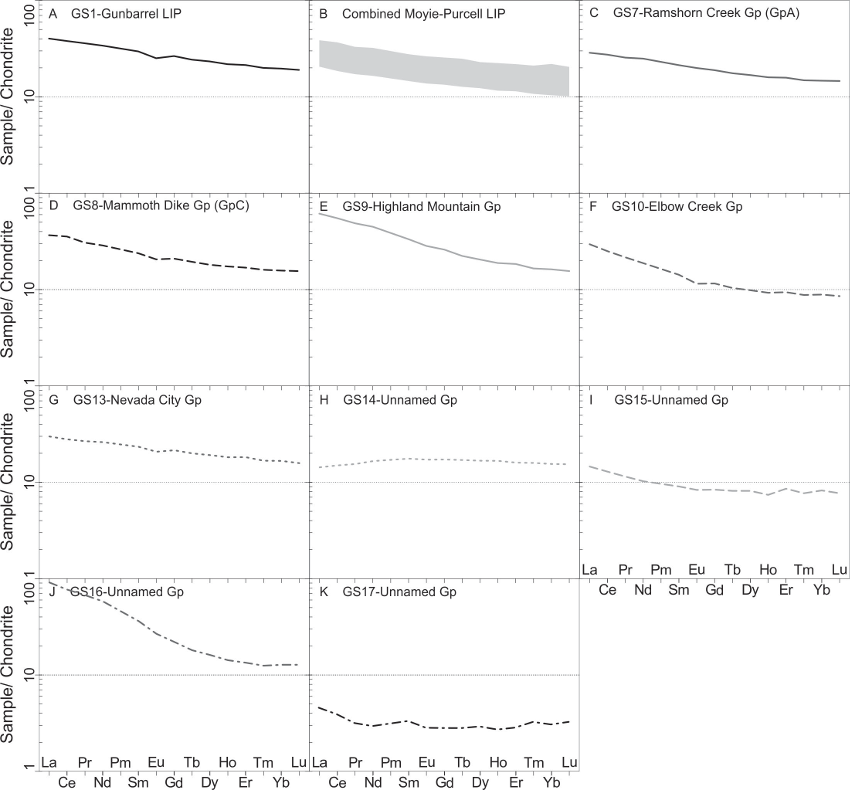
Figure 4: Average of most primitive magmas, normalized to chondrite, for the 17 mafic geochemical groups in western Laurentia. Modified from Rogers et al. (2016a).
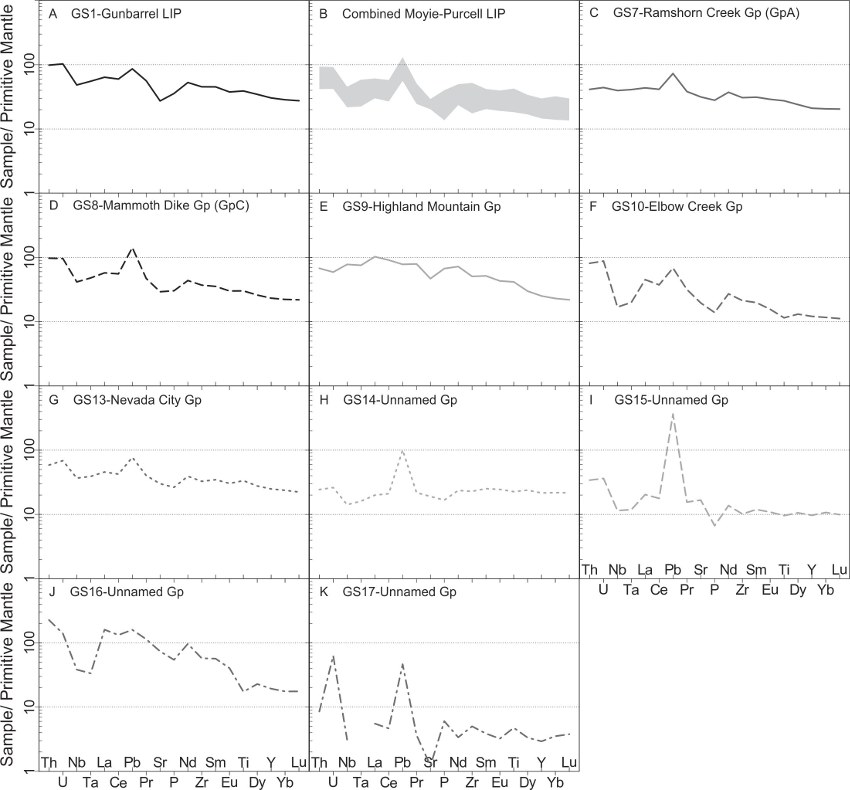
Figure 5: Average of most primitive magmas, normalized to primitive mantle, for the 17 mafic geochemical groups in western Laurentia. Modified from Rogers et al. (2016a).
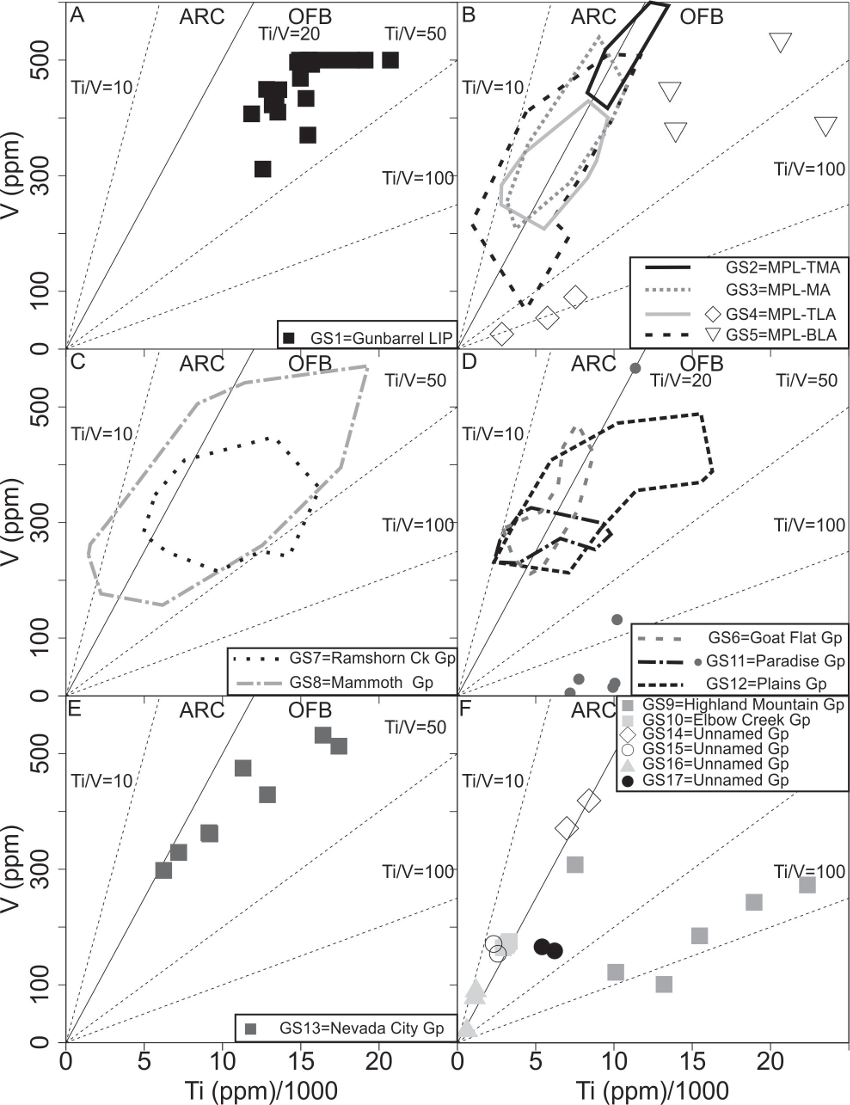
Figure 6: Plot of Ti vs. V for the 17 geochemical groups in western Laurentia. Modified from Rogers et al. (2016a).
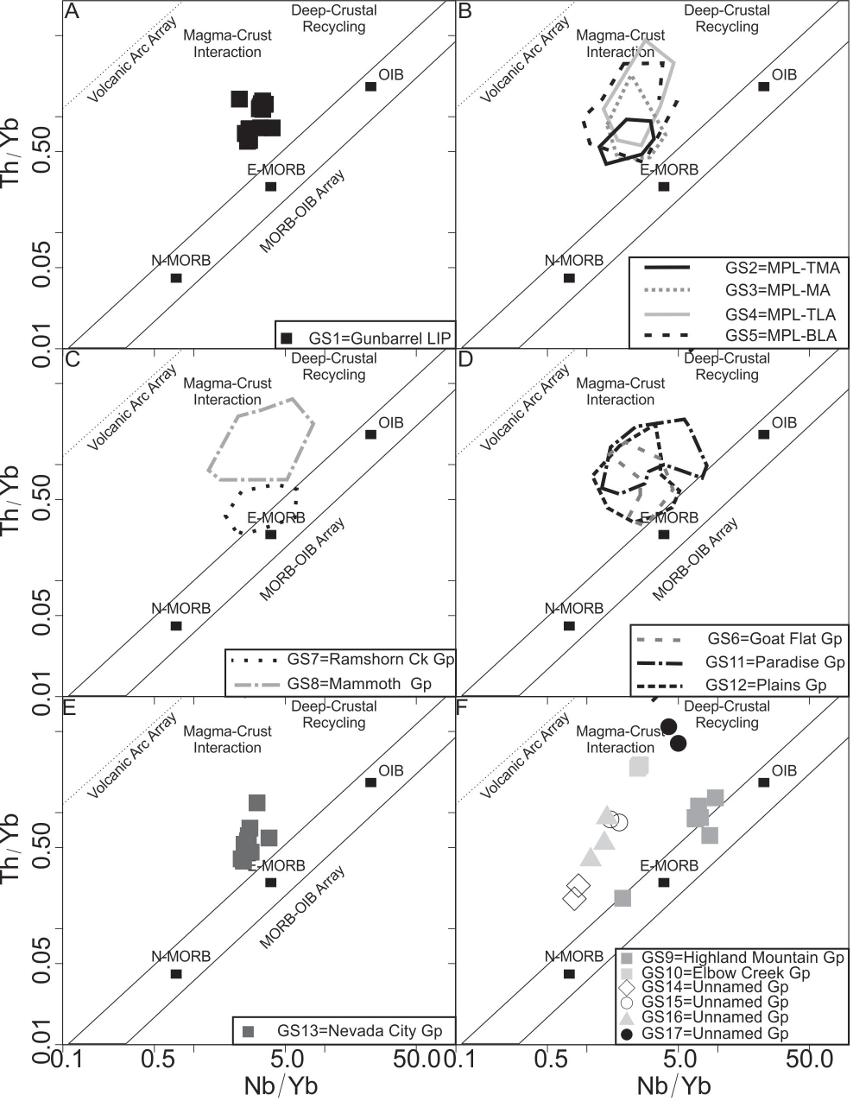
Figure 7: Pearce (2008) Th/Yb vs. Nb/Yb diagram for the 17 geochemical groups in western Laurentia. Modified from Rogers et al. (2016a).
Of the 17 geochemical groups, seven of them can be correlated to the Moyie-Purcell LIP which can be further subdivided into subgroups of ca. 1450, ca. 1460 Ma and ca. 1470 Ma pulses (Rogers et al. 2016a). Two other groups belong to a newly recognized 1550-1590 Ma Tobacco Root Mountain event (highlighted more below), and another belongs to the well-known ca. 780 Ma Gunbarrel LIP (Mackinder, 2014; Sandeman et al. 2014, and references therein). Three additional distinct geochemical groups are in the process of being precisely dated by U-Pb methods, and preliminary indications are that these groups also have different ages. The final four geochemical groups are each expressed by three or fewer samples, and though localized to specific areas, may characterize important unrecognized intraplate events.
Geochemical Signatures (GS) GS 7 and GS 8: Originally, geochemical groups GS 7 and GS 8, in the Tobacco Root Mountains were correlated to the Moyie-Purcell LIP (Ernst and Buchan 2010) via imprecise Rb-Sr and Sm-Nd ages (Wooden 1975; Harlan et al. 2008). However, Rogers et al. (2016a), noted that GS 7 and GS 8 represented distinct geochemical groups, and his prediction of their different ages is confirmed by new U-Pb dating of ca. 1550 and 1590 Ma, respectively (Rogers et al. 2015; Rogers et al. 2016b). The two groups are now named the ca.1550 Ma Ramshorn Creek (GS 7) and ca. 1590 Ma Mammoth (GS 8) groups, and are considered parts of the Tobacco Root Mountain event (Rogers et al., 2015, Rogers et al., 2016a). The geochemical differences between the 1590 Ma Mammoth and 1550 Ma Ramshorn Creek groups appear to reflect moderate levels of mantle lithospheric contamination in the former, but minimal influence in the latter (e.g. Figures 5, 7, 8).
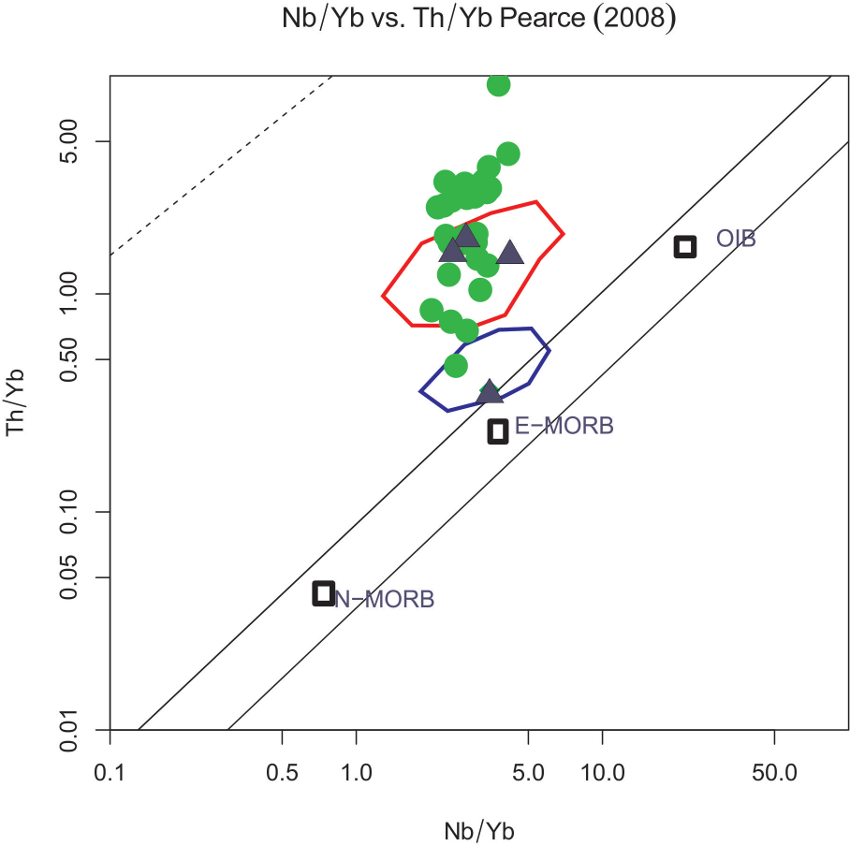
Figure 8: Pearce (2008) Th/Yb vs. Nb/Yb diagram with data from the Tobacco Root Mountain event (red and blue outlines for 1590 Ma Mammoth and 1550 Ma Ramshorn Creek groups, respectively), Western Channel Diabase (cyan triangles) and the Gawler Range mafic volcanics (orange circles). The latter data were obtained from Champion et al. (2007) and references therein.
Ages of 1590 Ma, that match with the Mammoth group age, have been obtained for the Western Channel Diabase (2000 km north in the Great Bear Lake area of NW Laurentia) and also in the Gawler Range mafic volcanics (Gawler craton, Australia), which was reconstructed adjacent to NW Laurentia at this time (Hamilton and Buchan, 2010).
A geochemical comparison of the 1550-1590 Ma units in the Tobacco Root Mountains with the 1590 Ma Western Channel Diabase and Gawler Range volcanics is shown in Figure 8. Three Western Channel samples plot with the Mammoth Group, but one plots in the 1550 Ma Ramshorn Creek grouping. The Gawler Range mafic magmatism mostly plots with the 1590 Ma Mammoth Group data but some plots to even more contaminated levels. Overall, as shown in Figure 8 there is a broad linkage of all these 1550-1590 Ma data (in the Tobacco Root Mountains of western Laurentia, northwestern Laurentia, and formerly attached Gawler craton) to variable lithospheric contamination of an EMORB type source.
The new ca. 1550 and 1590 Ma ages of the Ramshorn Creek and Mammoth groups also help solve an aspect of the Meso- to Neoproterozoic Laurentian apparent polar wander path (APWP), previously constructed assuming a Moyie-Purcell (1460 Ma) age (Figure 9; APWP not shown). The mean paleomagnetic directions for dykes from the Tobacco Root Mountains from Harlan et al. (2008), now recognized to have 1550 and1590 Ma ages (Ramshorn Creek and Mammoth groups), are compared with the direction for the ca. 1590 Ma Western Channel Diabase pole (Hamilton and Buchan, 2010) after extrapolation into the coordinates for the Tobacco Root Mountains. The difference between Tobacco Root Mountain and Western Channel paleomagnetic directions is explained by block tilting of the Tobacco Root Mountain sites due to the Laramide and younger deformation (yielding a tectonic correction of strike / dip of 002º / 19º). A similar correction explains the offset in the 780 Ma paleomagnetic direction in the Tobacco Root Mountains with respect to a reference paleomagnetic direction for the 780 Ma Gunbarrel event (Rogers et al. 2015; Rogers et al. 2016b).
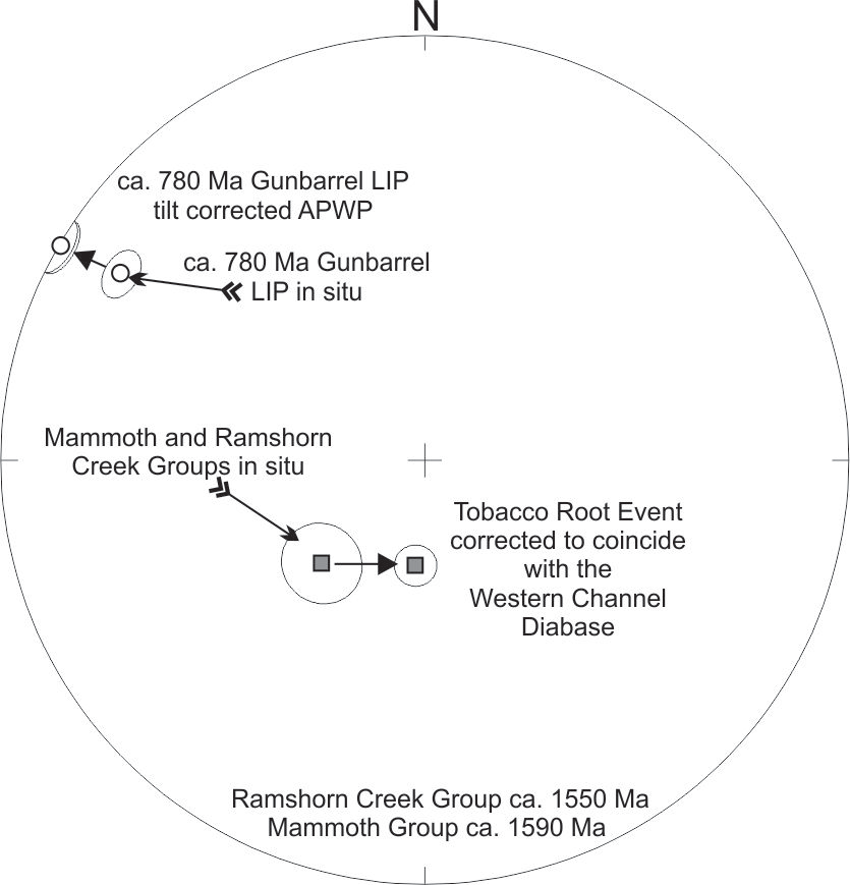
Figure 9: Equal-area projection showing in situ paleomagnetic data at c. 1550-1590 and 780 Ma of the Tobacco Root Mountains in comparison with reference key paleomagnetic poles. Details in text. Equal-area projection with the solid symbols plotted on the lower hemisphere and open circles plotted on the upper hemisphere. Modified from Rogers et al. (2015) and Rogers et al. (2016b).
This project has demonstrated the potential of geochemical studies to identify anomalous magmatic suites, to predict distinct igneous events, and target units for follow-up geochronological investigations. In this case, the combination of geochemistry and U-Pb geochronology has exposed the presence of a previously unrecognized 1590 - 1550 Ma Tobacco Root Mountain event (ongoing studies are aimed at understanding whether this is a single long-lived event, or two distinct periods of mafic magmatism). The orientation of dykes in the Tobacco Root Mountain event is indistinguishable from the regional ca. 1460 and 780 Ma Proterozoic mafic dykes. Therefore, dyke orientations, whether they are radial or linear, cannot be used in isolation to determine LIP associations.
For example, in a paleomagnetic study of dykes in the Beartooth Mountains, Montana, a dyke thought to be a splay of late Paleoproterozoic Sourdough swarm was sampled for geochemistry and paleomagnetism (Kilian et al. in revision). However, its εNd value yielded a value that was anomalously high compared to other Sourdough dykes. When recalculated to 780 Ma, the age of the Gunbarrel LIP, the recalculated εNd for this lone dyke was an exact match to that of other Gunbarrel intrusions (Cousens, B. and Kilian, T. pers. comm., 2016).
Another example is an interpretation linking the Irene and Huckleberry volcanics in northern Washington State (USA) with the ca. 780 Ma Gunbarrel LIP by Harlan et al. (2003), based on an Sm-Nd age (Devlin et al. 1988) and proximity to the Gunbarrel LIP. However Mackinder (2014) was able to show that the Irene and Huckleberry volcanics are geochemically and isotopically distinct from the Gunbarrel LIP. She interpreted that the Irene and Huckleberry volcanic rocks were not fed from Gunbarrel intrusions and they may be rift volcanics associated with the break up of Rodinia, and could correspond to a later pulse of the Gunbarrel LIP.
Conclusions
Geochronological, paleomagnetic and dyke orientation studies have proven important for determining the overall extent of LIP events within a crustal block and for reconstruction of matching LIP units between formerly neighboring crustal blocks. However, geochemical studies can furnish equally important constraints on the distribution of individual LIPs. The additional evidence that geochemistry provides can allow LIPs to be parsed into distinct compositional groups that represent either magma batches with distinct differentiation histories within a single LIP, or intermixed magmatic units that belong to different LIPs. The application of our geochemical studies to intraplate Proterozoic mafic igneous units in western Laurentia has provided compositional ‘fingerprints’ that allow recognition of 17 individual geochemical groups of which 9 appear distinct from the ca. 1460 Ma Moyie-Purcell and ca. 780 Ma Gunbarrel LIPs, and likely represent distinct events of different age(s). This hypothesis has been confirmed through subsequent U-Pb dating of two of these groups, yielding discrete ages at ca. 1550 and ca. 1590 Ma.
Acknowledgement
Helpful comments on this LOTM by Mike Hamilton are gratefully appreciated.
Click to open/close ReferencesReferences
Anderson, H. E., and Davis, D. W., 1995, U-Pb geochronology of the Moyie Sills, Purcell Supergroup, southeastern British Columbia; implications for the Mesoproterozoic geological history of the Purcell (Belt) Basin: Canadian Journal of Earth Sciences, v. 32, no. 8, p. 1180-1193.
Anderson, H. E., and Goodfellow, W. D., 2000, Geochemistry and isotope chemistry of the Moyie Sills; implications for the early tectonic setting of the Mesoproterozoic Purcell Basin: Special Publication (Geological Association of Canada. Mineral Deposits Division), v. 1, p. 302-321.
Bleeker, W., and Ernst, R., Short-lived mantle generated magmatic events and their dyke swarms: The key unlocking Earth's palaeogeographic record back to 2.6Ga, in Proceedings 5th International Dyke Conference: Dyke Swarms - Time Markers of Crustal Evolution, IDC-5, July 31, 2005 - August 3, 2005, Rovaniemi, Finland, 2006, Taylor & Francis - Balkema, p. 3-26.
Burtis, E. W., Sears, J. W., and Chamberlain, K. R., 2007, Age and petrology of Neoproterozoic intrusions in the Northern Rocky Mountains, U. S. A.; correlation with the Gunbarrel magmatic event: Special Publication - Society for Sedimentary Geology, v. 86, p. 175-191.
Chamberlain, K. R., Sears, J. W., Frost, B. R., and Doughty, P. T., 2000, Ages of Belt Supergroup deposition and intrusion of mafic dikes in the central Wyoming Province; evidence for extension at ca. 1.5 Ga and 1.37 Ga and potential piercing points for Rodinia reconstructions: Abstracts with Programs - Geological Society of America, v. 32, no. 7, p. 319.
Champion, D. C., Budd, A. R., Hazell, M. S., and Sedgmen, A., 2007, OZCHEM National Whole Rock Geochemistry Dataset: Australia, Commonwealth of Australia. http://www.ga.gov.au/metadata-gateway/metadata/record/gcat_65464
Devlin, W.J., Brueckner, H.K., and Bond, G.C., 1988. New isotopic data and a preliminary age for volcanics near the base of the Windermere Supergroup, northeastern Washington, U.S.A. Canadian Journal of Earth Sciences, v. 25, p. 1906-1911.
Doughty, P. T., and Chamberlain, K. R., 1996, Salmon River Arch revisited; new evidence for 1370 Ma rifting near the end of deposition in the middle Proterozoic Belt Basin: Canadian Journal of Earth Sciences = Journal Canadien des Sciences de la Terre, v. 33, no. 7, p. 1037-1052.
Doughty, P. T., and Chamberlain, K. R., 2008, Protolith age and timing of Precambrian magmatic and metamorphic events in the Priest River complex, northern Rockies: Canadian Journal of Earth Sciences, v. 45, no. 1, p. 99-116. 10.1139/E07-067. http://dx.doi.org/10.1139/E07-067
Ernst, R. E., 2014, Large Igneous Provinces, Cambridge University Press, 653 p.
Ernst, R. E., and Buchan, K. A., 2010, Geochemical database of Proterozoic intraplate mafic magmatism in Canada, Geological Survey of Canada, Ottawa, ON Canada, Open-File Report 6016 - Geological Survey of Canada.
Evans, K. V., Aleinikoff, J. N., Obradovich, J. D., and Fanning, C. M., 2000, SHRIMP U-Pb geochronology of volcanic rocks, Belt Supergroup, western Montana: Evidence for rapid deposition of sedimentary strata: Canadian Journal of Earth Sciences, v. 37, no. 9, p. 1287-1300. 10.1139/cjes-37-9-1287. http://dx.doi.org/10.1139/cjes-37-9-1287
Hamilton, M. A., and Buchan, K. L., 2010, U-Pb geochronology of the Western Channel Diabase, northwestern Laurentia: Implications for a large 1.59Ga magmatic province, Laurentia's APWP and paleocontinental reconstructions of Laurentia, Baltica and Gawler craton of southern Australia: Precambrian Research, v. 183, no. 3, p. 463-473. 10.1016/j.precamres.2010.06.009. http://dx.doi.org/10.1016/j.precamres.2010.06.009
Harlan, S. S., Geissman, J. W., and Snee, L. W., 1997, Paleomagnetic and 40Ar/39Ar geochronologic data from late Proterozic mafic dikes and sills, Montana and Wyoming: US Geological Survey Professional Paper, no. 1580.
Harlan, S. S., Heaman, L., LeCheminant, A. N., and Premo, W. R., 2003, Gunbarrel mafic magmatic event: A key 780 Ma time marker for Rodinia plate reconstructions: Geology, v. 31, no. 12, p. 1053-1056.
Harlan, S. S., Premo, W. R., Unruh, D., and Geissman, J. W., 2005, Isotopic dating of Meso- and Neoproterozoic mafic magmatism in the southern Tobacco Root Mountains, southwestern Montana: Precambrian Research, v. 136, no. 3-4, p. 269-281. 10.1016/j.precamres.2004.10.008. http://dx.doi.org/10.1016/j.precamres.2004.10.008
Harlan, S. S., Geissman, J. W., and Snee, L. W., 2008, Paleomagnetism of Proterozoic mafic dikes from the Tobacco Root Mountains, southwest Montana: Precambrian Research, v. 163, no. 3-4, p. 239-264. 10.1016/j.precamres.2007.12.002. http://dx.doi.org/10.1016/j.precamres.2007.12.002
Mackinder, A.J., 2014. A petrographic, geochemical and isotopic study of the 780 Ma Gunbarrel Large Igneous Province, western North America. PhD thesis, Department of Earth Sciences, Carleton University, 154 p.
Mueller, P. A., and Rogers, J. J. W., 1973, Secular Chemical Variation in a Series of Precambrian Mafic Rocks, Beartooth Mountains, Montana and Wyoming: Geological Society of America Bulletin, v. 84, no. 11, p. 3645-3652.
Pearce, J. A., 2008, Geochemical fingerprinting of oceanic basalts with applications to ophiolite classification and the search for Archean oceanic crust: Lithos, v. 100, no. 1-4, p. 14-48. 10.1016/j.lithos.2007.06.016. http://dx.doi.org/10.1016/j.lithos.2007.06.016
Reed, J. C., Jr., and Zartman, R. E., 1973, Geochronology of Precambrian Rocks of the Teton Range, Wyoming: Geological Society of America Bulletin, v. 84, no. 2, p. 561-582.
Rogers, C., Ernst, R. E., Cousens, B., Harlan, S. S., and Soderlund, U., 2015, Newly discovered 1550 Ma mafic magmatism in the Tobacco Root Mountains, MT USA: An end to the North American Magmatic Gap?, AGU-GAC-MAC Joint Session: Montreal PQ.
Rogers, C., Mackinder, A., Ernst, R., and Cousens, B., 2016a, Mafic magmatism in the Belt-Purcell Basin and Wyoming Province of western Laurentia: Geological Society of America Special Papers, v. 522.
Rogers, C., Ernst, R. E., Cousens, B., Soderlund, U., Hamilton, M., and Harlan, S. S., 2016b, Newly recognized 1550-1590 Ma Tobacco Root -Western Channel LIP, and further evidence for bringing South Australia back home to Western Laurentia., GAC-MAC: Whitehorse, YT, GAC-MAC.
Sandeman, H. A., Ootes, L., Cousens, B., and Kilian, T., 2014, Petrogenesis of Gunbarrel magmatic rocks: Homogeneous continental tholeiites associated with extension and rifting of Neoproterozoic Laurentia: Precambrian Research, v. 252, p.166-179
Sears, J., Chamberlain, K. R., and Buckley, S. N., 1998, Structural and U-Pb gical evidence for 1.47 Ga rifting in the Belt basin, western Montana: Canadian Journal of Earth Sciences, v. 32, p. 467-475.
Wooden, J. L., 1975, Geochemistry And Rubidium-Strontium Of Precambrian Mafic Dikes From The Beartooth, Ruby Range, And Tobacco Root Mountains, Montana [PhD.: The University of North Carolina at Chapel Hill, 194 p.
Wooden, J. L., Vitaliano, C. J., Koehler, S. W., and Ragland, P. C., 1978, The late Precambrian mafic dikes of the southern Tobacco Root Mountains, Montana: geochemistry, Rb-Sr geochronology and relationship to Belt tectonics: Canadian Journal of Earth Sciences, v. 15, no. 4, p. 467-479.
Zartman, R. E., Peterman, Z. E., Obradovich, J. D., Gallego, M. D., and Bishop, D. T., 1982, Age of the Crossport C Sill near Eastport, Idaho: Bulletin - Idaho Bureau of Mines and Geology, v. 24, p. 61-69.